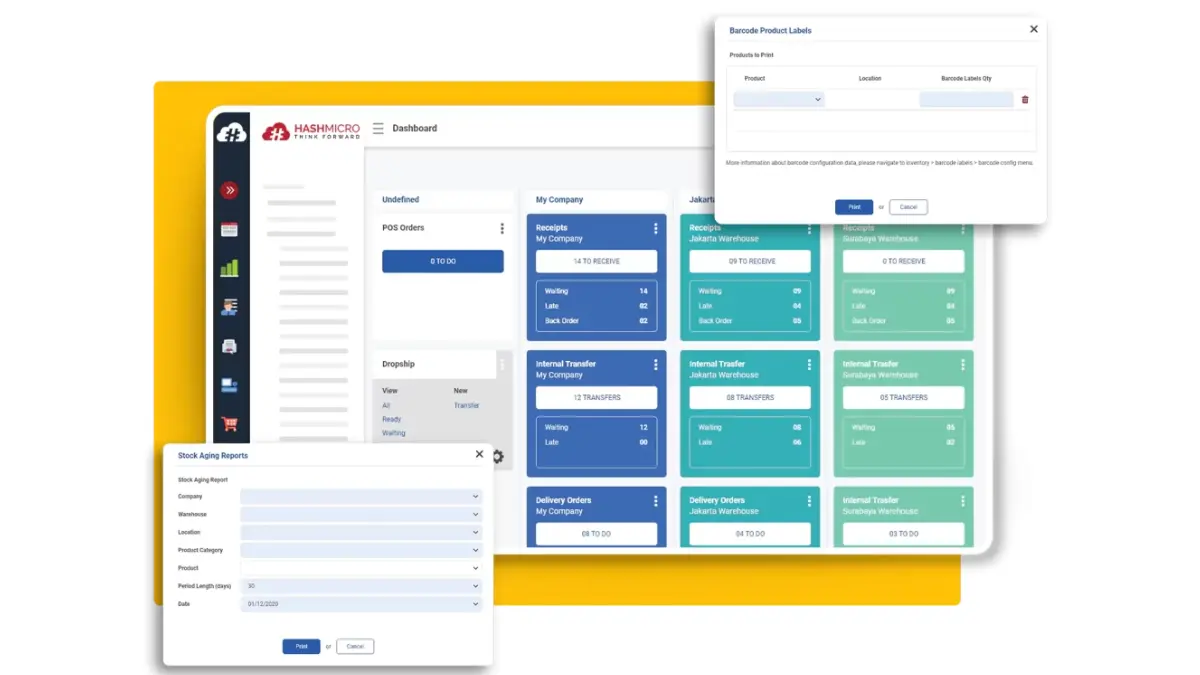Did you know that poor inventory allocation can sink a thriving business? Inventory allocation optimizes your stock across channels, ensuring you meet customer demands without the pitfalls of overstocking or overselling.
A staggering 91% of consumers are less likely to shop with a retailer again after a negative experience like a stockout, making effective allocation even more critical.
This crucial aspect of supply chain management is your secret weapon in maximizing profits and enhancing operational efficiency—especially if you’re planning to scale. Ready to transform your business? Dive into the world of effective inventory allocation!
Key Takeaways
|
Table of Contents
What is Inventory Allocation?
Inventory allocation is the strategic process of distributing stock across multiple sales channels and physical locations, including warehouses, stores, and fulfillment centers. It ensures that the right products are in the right place at the right time, balancing stock levels to meet customer demand efficiently.
This delicate balance is essential for businesses in the Philippines, where logistical challenges and supply chain disruptions can directly impact customer service and overall profitability. If inventory is poorly distributed, businesses risk understocking, leading to stockouts.
Why is Inventory Allocation Important?
Effective inventory allocation goes beyond just balancing stock levels; it directly influences a business’s profitability and ability to scale. You can significantly prevent product shortages and meet customer demands on time by keeping the right amount of stock. This proactive approach ensures efficiency and improves customer satisfaction.
Moreover, efficient inventory allocation supported by inventory aging insights, helps free up working capital allowing companies to invest in growth opportunities rather than tying up resources in unsold goods.
This strategic advantage is especially important because inventory mismanagement can lead to heavy financial losses and loss of loyalty.
Benefits of Strategic Inventory Allocation
Strategic inventory allocation offers several benefits for businesses, particularly in managing stock levels and ensuring operational efficiency across various channels. These benefits of an inventory management system can prevent costly issues like overstocking, overselling, and managing multiple sales channels efficiently.
- Enhancing Multichannel Management: Ensures optimal stock levels across channels, improving customer satisfaction and reducing fulfillment delays
- Scalability Foundations: Supports business growth by streamlining inventory management across multiple locations, improving flexibility
- Improved Cash Flow: Reduces excess stock, freeing capital for reinvestment and improving financial flexibility
- Faster Order Fulfillment: Speeds up delivery by positioning inventory closer to demand centers, cutting shipping costs
- Supply Chain Efficiency: Minimizes transit time, enhancing responsiveness to market demand and reducing supply chain delays
By implementing strategic inventory allocation, businesses can better handle stock levels, enhance customer satisfaction, and set the stage for growth, ensuring they remain competitive in both local and international markets.

Best Methods to Manage Inventory Allocation
Inventory allocation methods vary depending on the operational structure and specific needs of a business. This process is essential in minimizing inventory costs, meeting customer demand, and maintaining smooth supply chain operations. Some of those methods are:
| Method | Definition |
|---|---|
| Push Allocation | Products are “pushed” to different locations based on demand forecasts. This method relies on historical sales data that can confidently predict demand trends. |
| Pull Allocation | Stock is allocated based on customer orders, reducing the risk of overstocking. Ideal for businesses looking to stay agile and avoid unnecessary inventory costs. |
| Just-in-Time Allocation | A hybrid method where stock is ordered or produced just in time to meet customer demand, minimizing excess inventory but requiring accurate forecasting. |
| Equal or Universal Allocation | Inventory is distributed equally across all channels, simplifying management. However, if demand varies significantly across regions, this can lead to inefficiencies. |
| Tier-based Allocation | Prioritizes high-demand or important locations, ensuring sufficient stock where it’s most needed. It’s ideal for businesses with a clear hierarchy of sales priorities. |
| Cluster-based Allocation | Groups similar locations or channels together and allocates inventory based on collective demand. This method offers flexibility for regions with similar demand patterns. |
| Demographic-based Allocation | Stock is allocated based on the demographic needs of target markets, such as urban versus rural areas. It ensures that unique preferences are met. |
| Demand-based Allocation | Uses sales data and trends to match stock levels with real-time demand. It helps businesses prevent stockouts by being responsive to the market. |
Each method has its advantages and drawbacks, depending on the level of demand predictability, business size, and resources available. Many businesses use a combination of these methods, supported by an inventory management system, to optimize their inventory allocation.
Challenges in Allocating Inventory
Inventory allocation poses several challenges for businesses, particularly those managing multiple locations or sales channels. These challenges can disrupt efficient stock distribution. Some of which you need to be aware of are:
- Fluctuating Demand: Predicting demand accurately is difficult, especially with market volatility or seasonal peaks. Misjudging demand leads to stockouts or overstocking, causing lost sales or excess inventory that ties up capital
- Inaccurate Data: Without real-time data, businesses risk making poor allocation decisions. Inaccurate or delayed inventory data can lead to inefficiencies, including misplaced stock and imbalanced inventory across locations
- Storage Limitations: Limited warehouse space and high storage costs make it difficult to hold excess inventory control. Poor allocation can lead to overcrowding or underutilized space, increasing operational expenses
To address these challenges, businesses should implement real-time inventory visibility and data-driven decision-making systems. Using automated tools and regularly reviewing inventory performance allows Filipino businesses to make informed adjustments and ensure efficient stock management.
Best Practices for Inventory Allocation
To efficiently manage inventory allocation, businesses can follow five key steps. Each step offers a practical approach to balancing inventory and meeting customer demand.
- Use Real-time Data for Decision Making: Utilizing real-time data will allow you to make informed and timely decisions regarding inventory distribution.
- Prioritize Items with Shorter Shelf Lives: For businesses that handle perishable goods, prioritizing products with shorter shelf lives reduces waste and maximizes freshness.
- Automate Inventory Allocation Processes: Automated systems can dynamically adjust stock levels based on sales data, ensuring the right amount of inventory is distributed across different locations without manual intervention.
- Consider Regional Demand: Tailoring inventory levels to regional demand ensures that high-demand areas are well-stocked while avoiding excess inventory in low-demand regions.
- Review and Adjust Regularly: Regularly reviewing your inventory performance will allow you to adapt your allocation strategies as needed.
By following these steps, businesses can enhance their inventory management in the Philippines, boost customer satisfaction, and reduce operational costs.
Factors to Consider in Effective Inventory Allocation
Effectively Allocate Inventory Using HashMicro’s Inventory Management System
Effectively managing inventory is crucial for any business, and HashMicro’s Inventory Management System offers the tools needed to optimize this process. Whether you’re dealing with a single warehouse or multiple locations, the system provides the functionality to ensure that your stock is allocated efficiently.
HashMicro’s system comes with a suite of advanced features designed to streamline inventory management. Some of those features are:
- RFID Warehouse Rack Stock Automation: This feature enables automatic stock-in and stock-out processes using RFID technology, improving accuracy and reducing manual errors.
- Fast Moving and Slow Moving Stocks Analysis: This tool helps businesses analyze stock movement, allowing them to optimize inventory by focusing on fast-moving items and addressing slow-moving stock.
- Product Expiry Management: The system tracks product expiration dates, helping businesses manage perishable goods efficiently and avoid wastage due to expired products.
- Stock Forecasting: Advanced forecasting tools enable businesses to predict future stock requirements based on historical data and trends, ensuring optimal inventory levels.
- Picking Wave with Priority: This feature prioritizes picking tasks across multiple locations, improving the efficiency of order fulfillment by showing which items need to be picked first.
By leveraging these advanced features, HashMicro’s Cloud Inventory Management System helps businesses enhance their stock allocation processes, minimize waste, and ensure timely delivery to customers.
Conclusion
Effective inventory allocation is a critical aspect of supply chain management, influencing both customer satisfaction and business profitability. By balancing stock levels across multiple locations and using data-driven strategies, businesses can avoid the pitfalls of overstocking and understocking.
This not only ensures smoother operations but also provides a strong foundation for growth, especially for businesses looking to scale. HashMicro’s Inventory Management System offers powerful features such as RFID automation, stock forecasting, and priority-based picking waves to optimize inventory management.
These tools enhance efficiency, reduce waste, and ensure that products are always available where and when they are needed. Want to see these features in action? Sign up for a free demo today and experience how HashMicro can revolutionize your inventory management!

Frequently Asked Questions
-
What are factors to consider in inventory allocation?
Key factors include customer demand, stock levels, and available storage space. Businesses should also consider regional demand and reallocation strategies for unexpected changes.
-
What does allocation mean in warehouse?
Warehouse allocation refers to placing inventory in the right locations for efficient storage and retrieval. It helps optimize space and speeds up order fulfillment processes.
-
What is the meaning of stock allocation?
Stock allocation is the strategic distribution of inventory across various locations to meet demand. It ensures products are available where needed, minimizing overstock or shortages.














































